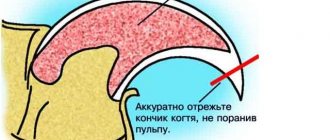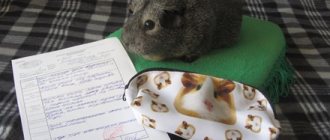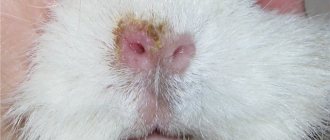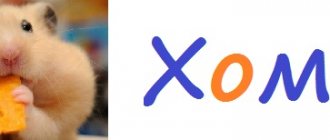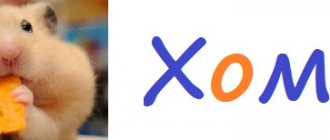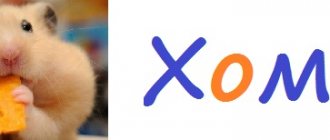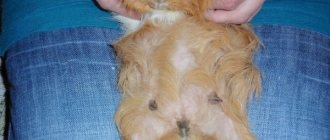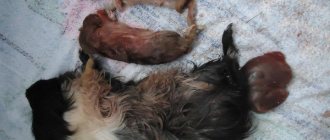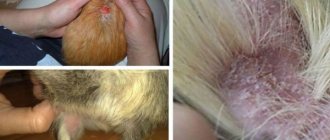- home
- Guinea pig
- General information about guinea pigs
02/15/2019 Few people know that guinea pigs are trainable and can learn dozens of tricks. They are taught commands of varying degrees of complexity. The secret of training lies in the patience and perseverance of the owner. The result depends on the pet itself. Some animals learn information faster, others slower, or even like to be stubborn. If the owner adheres to the correct algorithm for processing commands, his efforts will be crowned with success.
What you need to know
Guinea pig training is based on using the animal's natural behavior as the basis for training. The action that the pet performs is preceded by a sound signal (verbal command, click, whistle), and reinforced with encouragement. The behavior and reactions of each pig are individual, so before training you should study the pet’s character and get to know him better. Give him the opportunity to get used to the owner and his hands. Demonstrate good intentions with calm demeanor and occasional treats. The optimal time for getting to know each other is 2-3 weeks from the date of purchase of the animal. After this, you can begin training.
Training is carried out subject to the following conditions:
- Coordination with feeding schedule. The pet is more willing to work for a treat when hungry.
- Calm environment. Exercises will be more successful in the absence of external stimuli - people, animals, TV.
- The animal is on a hard surface - this way it feels confident and is less distracted.
- The duration of the lesson is no more than 10 minutes.
A word, whistle or clicker is used as a command. Over time, the pig will get used to associating the sound with a certain action.
During exercise, the pet and owner should be in a favorable state and show no signs of fatigue or irritation. A bad mood will complicate the task for both parties and will not lead to positive results.
Recommendations and tips
When training domestic guinea pigs, you should consider the following recommendations:
- Both parties (animal and human) must be in a calm psychological state during training. If there are disturbing factors, classes must be rescheduled.
- The animal must have a sense of solid grounding. All classes should be conducted on a flat, hard surface. Exercise at heights can frighten the animal. You should not train your pig while holding it suspended.
- Sound signals should not cause fear or alarm.
- It is difficult to stimulate an animal that has eaten well to take any action. It is better to carry out training before feeding. A hungry pig will be especially drawn to treats. Of course, you cannot keep your pet hungry for the sake of training; you should simply accustom him to a certain feeding regimen, taking into account the classes in the schedule.
- Training should not tire the animal. They should be carried out regularly, daily, but lasting no more than 10-15 minutes.
- You cannot punish your pet for wrong actions. He can only be encouraged to behave correctly.
An important condition for effective training is the animal’s trust in its owner. This attitude is earned gradually
You cannot start training from the first day after purchasing a pet. The animal must get used to the cage and general environment, the owner and the entire family. Within 2-4 days he will just get accustomed to his new home. The owner needs to show maximum care. It is recommended to periodically pick up the animal and caress it. You need to hold the animal firmly enough, but not squeeze the body. Full adaptation can take place within 2-3 weeks.
Despite the fact that guinea pigs are considered cautious and timid animals, they are quite easy to train. With the right approach, animals acquire the necessary reflexes, which are stimulated by rewards. Patience and a caring attitude make it possible to provide training at home, without the involvement of specialists. Guinea pigs are capable of mastering both simple actions and complex tricks based on a conditioned signal.
Taming
You should not constantly handle the pig immediately after purchase. The pet is given time to get used to the new environment and strangers. If the animal is very nervous, the cage is covered with a translucent blanket. This creates the illusion of privacy and the animal relaxes.
After a few days, they begin to carefully pick up the animal. Hold it tightly enough, but not too tightly, otherwise it will hurt the pig. The second hand is used to support the pet from below. This will help the animal feel stable and safe.
You need to talk to the pig often and say its name. Use a soft and friendly tone. From time to time the pet is offered treats. All this creates a positive image of the owner in the animal’s head. He will understand that this person is not dangerous. Depending on the character of the animal, taming takes from 2 weeks.
First steps
How to train a guinea pig at home? Do you want your animal to listen to you and perform the suggested tricks? To do this, you need to be sure that it completely trusts you.
These animals are very cautious and timid by nature.
Sudden movements and sounds are stressful for them, so you need to remember that such a pet requires an affectionate attitude towards itself, and you need to pick it up when taking it out of the cage very carefully and carefully, and hold it tightly, but without squeezing, so that the rodent does not become break free
You need to start by learning the simplest commands:
- respond to nickname
- serve,
- perform a circular turn,
- kiss.
“Come to me, Mukhtar!”
You need to constantly accustom the animal to the sound of its nickname, saying it often near the cage, repeating it during feeding, and talking to it.
The “technology” of training is simple. To train a guinea pig to follow this command, it is recommended to take the animal out of the cage and place it at a short distance from you. The distance during subsequent classes should be gradually increased.
Do you know what your pet likes? So offer her this treat while calling her by name. The rodent will certainly react appropriately and reach out to you. And when she comes running, reward her with a treat and praise her.
Repeat this exercise at least once a day. The pig will gradually get used to receiving his favorite treat in response to a command and will begin to respond even while in the cage.
You can also call your pet with some conventional sound - whistling, clicking your tongue.
A treat must be earned
The “Serve” command is processed in a similar way. Here, too, the offered treat plays an important role, say, a bunch of grass, which, after pronouncing the command, must be held above the animal’s head in such a way that the rodent, reaching it, is forced to rise on its hind legs. As soon as he succeeds, give him an honestly earned treat.
This also needs to be done regularly. A pet trained to this command will carry it out even if a treat is not forthcoming.
All around, march!
The execution of the “Turn” command is also practiced by repeating it many times. When playing with the little animal, call it to you and, holding the treat in front of its nose or a little higher, move your hand in a circle, while commanding: “Turn around!” or “All around!” It is necessary for the guinea pig to learn to follow the movement of the hand and turn around in a circle. Later she must do this without reward.
Let's kiss, my friend!
This simple trick can be taught to your pet this way. Whenever you take him out of the cage, it is recommended to hold a twig of something attractive from the guinea pig's point of view between your lips. Parsley may be beneficial for both you and her. Feed her mouth-to-mouth. After just a few “sessions,” the animal itself will reach for the lips of the breadwinner, obeying the same conditioned reflex. And this gesture very clearly imitates a kiss.
Upbringing
Guinea pigs begin training after the pet gets used to the owner and begins to trust him. First, simple commands are taught, moving on to complex ones.
One of the first lessons is the ban on damaging objects and furniture. When a pet finds itself outside its usual cage, it is naturally drawn to inspect everything and test its teeth. If the animal shows increased interest in wires or the same object, a spray or gel with a bitter taste is applied to these things. Such products are sold in pharmacies and are safe for animals.
In addition, a running pig should be kept in sight at all times. She can not only damage something, but also accidentally injure herself. The cage with the pet is placed away from curtains and other objects that the animal can freely reach. The lock of the cage must be reliable and strong.
Types of guinea pigs
There are more than two dozen breeds of guinea pigs - from the classic “rosettes,” as breeders call them, to luxurious long-haired Peruvian, English, alpacas, etc. The most original in appearance can be called, for example, curly Texels or Sheltie pigs - their long hair looks like it is combed back. Himalayan pigs are very interesting - they are called “Siamese” due to their color, like Siamese cats. Well, we can’t help but mention skinny pigs: this is a breed of sphinx pigs that have practically no hair.
Caring for pigs
When it comes to care, all pigs are practically the same - they need to regularly change trays with sawdust or other filler, feed them tasty food and brush them. The longer a pig's fur, the more difficult it is to care for: you need to comb, wash and cut. Especially long-haired or show pigs need professional grooming: they are washed with hair conditioner, thoroughly combed and fashionably trimmed. Pig luxury!
Toilet training
Keeping a pig at home requires frequent replacement of bedding. The process is simplified if the animal is accustomed to relieve itself in a tray, which is easier to wash than the cage tray.
Training takes place according to the following algorithm:
- A tray is installed in the cage in the area where the pet goes to the toilet.
- A little filler, soiled sawdust and pig feces are placed in the tray so that the pig can identify the purpose of the new item by smell.
- Give the animal a treat if it relieves itself in the right place. It may take him some time to do this.
It is worth remembering that some pigs do not like using the litter box. In such cases, training will not help. It all depends on the character and preferences of the pet. As a last resort, try installing additional trays in other corners of the cage. If the animal uses the tray as a house - carries hay and sleeps inside, you need to buy a regular house or exchange the existing one for a more spacious one.
Important nuances
Before taming a guinea pig, you need to study the characteristics of its psyche and behavior. All rodents love:
- Peace and quiet - noise or sharp sounds make the animal restless and even aggressive. In such conditions, classes will not bring positive results.
- An abundance of dry grass or litter in the cage - animals love to burrow into it.
- Fresh vegetables, herbs and fruits - they contain valuable elements that improve the health of the animal.
Some breeds are sensitive to temperature, get cold easily and can get sick. And when the rodent experiences discomfort, you can forget about taming. Never play with your guinea pig until it has become comfortable in its new environment. When you manage to tame a pet, you will receive a faithful friend in him and will be able to enjoy communicating with him.
https://homjakam.ru/morskaya-svinka/priruchat-k-rukam https://msvinkam.ru/soderzhanie/priruchit-morskuyu-svinku-k-rukam.html https://petse.ru/gryizun/morsk_svin/ kak-priruchit-morskuyu-svinku-k-rukam.html
Training to drink
Many pigs themselves understand the principle of operation of a mounted drinker; they do not require special training for this. As soon as they touch the ball, moisture comes out and they lick it off. This movement puts the drinker into action again. But some pets are afraid to touch an unfamiliar object. In such cases, the owner's help will be required. You need to touch the ball yourself and make the water come out. Then bring the animal closer so that it smells the moisture and tastes it.
If your pig hasn't used a water bottle for a while, she probably needs enough moisture from the succulent food included in her diet. She'll drink whenever she wants.
Why does he drink a lot?
There are many reasons why guinea pigs drink heavily. One of them is pregnancy in a female. In this position, the guinea pig drinks a lot of water. Another reason is illness. A hamster may drink a lot due to elevated body temperature. This replenishes all the necessary elements in the body. In winter, when houses are heated and the air dries out, guinea pigs' need to drink increases. In winter, pigs' diet changes. For the most part, they are fed hay, formula, and dry food.
Therefore, it is very important to feed your guinea pigs in a balanced manner, adding more vegetables, herbs and fruits. They contain moisture, which replenishes their fluid. Hyperactive rodents that run and play a lot also require plenty of fluids.
The animals are quite sensitive and can experience overexertion. This is also the reason for frequent drinking in the animal.
Hyperactive rodents that run and play a lot also require plenty of fluids. The animals are quite sensitive and can experience overexertion. This is also the reason for frequent drinking in the animal.
Team training
Guinea pig training begins after the pet gets used to the owner and begins to trust him. In conditions of tension and stress, learning will not bring results. Commands are given in a calm voice, even if the pet does not understand for a long time or is stubborn.
Stand
Training is carried out on a hard surface. The pet is shown a treat and raised above its head so that the animal has to stand on its hind legs. At the same time, the command is pronounced: “stand” (or use the words “up”, “serve”). As soon as the animal has straightened up, it is given a treat and praised.
To me
The pig is seated not far from you, shown a treat and pronounced its name (or the command “come to me”). You can accompany it with a hand movement - patting the leg, as is the case with dogs. When the animal runs up, it is sure to be treated. Gradually, the distance between the owner and the animal is increased to several meters.
U-turn
To practice this command, hold the treat just above the pig’s head, then slowly make a circular motion so that the pet, following the hand, turns around its axis. If an exercise turns out to be difficult for an animal, it is rewarded for partial completion - for example, for turning 90 degrees, then 180, and so on.
Kiss
The owner squeezes a treat or a little hay between his lips, then leans towards the pig. She smells food and reaches for it. Over time, the animal will perform this movement reflexively, even if the owner does not have any treats.
Give me your paw
The trick is learned using both hands. One holds the treat in front of the pet, slightly above its head; the second is placed palm up opposite the animal’s eyes. The owner says: “give me your paw,” and demonstrates the treat in such a way that the pig can only take it by rising on its hind legs. At the same time, she will place her front ones on her palm, which is located directly in front of her and prevents her from getting food.
Roll the ball
This exercise uses a treat in the form of hay or a vegetable cut into strips. A ball is placed on top of the food and the pig pushes it with its nose to move it away from the treat. At the same time, you need to say: “push the ball.” The ball used is a tennis ball or a small rubber one.
Jump through the ring
The ring is placed in front of the pet's muzzle. On the other side of him is a treat. To get food, the pig will have to go through a hoop. The words used as a command are: “in the ring.” It is permissible to gently push the animal if it is afraid to perform the trick. To do this you will need the help of a second person.
Take a large ring, at least 15 cm in diameter. At first, hold it low so that it touches the floor. Over time, they are raised, but not higher than three cm. You can use store-bought or homemade ones - made of wire or thick cardboard. The edges of the product must be smooth.
Making tricks more difficult
After mastering simple actions, you can complicate the training. We recommend several interesting tricks that are more difficult for a guinea pig. Stretching out its paw is not a very natural behavior for her. But this can be taught.
Training is carried out in this order. The animal is placed on a sofa or chair, and the owner sits on the floor. He extends one hand towards the pet, palm up. In the second hand, located a little further, there is a piece of “yummy”. The pig wants to reach for the treat, but the outstretched palm interferes. The animal has to rest one paw on the palm in order to get to the food. At this moment, the command “Give me a paw” or simply “Paw” sounds and a treat is given. Over time, the animal will put its paw on its palm simply on a signal, knowing that it will receive encouragement.
The pig “footballer” looks original. To teach her to roll a ball, you need to provide appropriate training. A flat slice of carrot or a sprig of herbs is placed under a small ball (for example, a tennis ball). Together with the command “Ball” or “Roll”, the pig rolls away the obstacle with its paw, freeing the product. With frequent repetition of the exercise, the animal develops a reflex of rolling the ball.
A real circus act - jumping through the ring. Training includes the following exercise. A ring with a diameter of 20-30 cm is installed between the animal and the treat. At the command “Ring” or “Jump” the pig rushes to the food. If your pig is hesitant to jump, you can give him a gentle push. Gradually the ring rises higher, and treats can be given from the hands. It is important to develop the necessary reflex. The height of the ring above the floor should not exceed 4-5 cm.
The gaze of others is attracted by the “parrot” pig, that is, an animal sitting on the owner’s shoulder. You can train your pet to this somewhat unusual position quite simply. To do this, a treat is placed on the shoulder, which the pig should feel. At the call “On the shoulder” she climbs up, and here she needs to be held back with an additional portion of encouragement. It should be remembered that the animal can be frightened by heights, and therefore everything must be done carefully and without sudden movements.
How to hold a pig correctly
In order for a pet to be able to trust its owner, it is necessary to know how to hold the animal correctly, since some methods can cause pain or frighten the animal.
Guinea pigs really don’t like to be without solid support under their paws, so keeping your pet suspended for a long time is not recommended. In addition, these animals are absolutely not adapted to falls: falling even from a low place can result in serious injury, so leaving your pet on a table or sofa without attention is prohibited.
The best way to hold this pet is in which one palm holds the front legs and covers the chest, and the second palm holds the back and back of the body.
You should hold the guinea pig carefully and firmly, without squeezing or squeezing the animal. It is most convenient to keep your pet in a sitting position.
Rolling the ball
We have already figured out how to train a guinea pig and teach it simple tricks. Now it's time to move on to the next stage. Now we will tell you how to teach a pig to roll a ball. First you need to do a little preparation. You need to find a ball that is not too heavy and not too big. For example, it could be tennis. A guinea pig can easily handle such a ball. In addition, you will need a flat and long treat. A strip of carrot is suitable for these purposes.
So, now let's move directly to the training. Place a carrot strip on the floor, then place a ball on it. After this, encourage the rodent to push the ball away so that he can get to the treat. At the same time, say the command “Push the ball.” You need to repeat these steps regularly. After a while, it will be possible to remove the treat from the learning process. The rodent will be able to roll the ball without it.
Simple wire cutters
The most primitive device is very similar to ordinary scissors. Only one of its cutting surfaces is equipped with a small notch with a sharp edge. Using such a device is easy, provided you have some skill and experience. For young dogs, nail trimming is always stressful. They do not want to sit quietly, they strive to tear the paw out of the owner’s hands and in every possible way complicate the process. So Litbro.ru will not recommend such a gadget to novice dog breeders. The risk of causing serious physical injury to your pet is too great. Well, for experienced owners who have used similar tools more than once, nothing better can be desired. Cheap and very effective.
Cost – 35 – 72 rubles.
More advanced versions of hand cutters offer expanded functionality.
Although their main part, in the old fashioned way, is based on two cutting surfaces. Service additions imply only human convenience. Models with rounded ends, a container for cut claws and lighting have proven themselves very well. The fact is that some dogs have the habit of looking for clipped ends on the floor and eating them. Sharp, bent cuttings can damage the stomach wall and cause bleeding. A small “waste collection” effectively solves this problem.
Price – 636 rub.
Another gadget from the line of simple nippers has comfortable ergonomic handles that allow you to securely hold the tool while trimming nails.
This is important when the animal gets nervous and breaks out.
We pay attention to one more detail - the expansion spring. It fixes the cutting surfaces in the open state, which makes the operation somewhat easier.
Otherwise, the functions of the device duplicate all the features of its predecessors. To properly shorten claws, you must have the skill and achieve unquestioning obedience from your dog or cat.
Cost – 229.93 rubles.
Features of feeding
In the wild, hamsters feed on plant seeds, nuts, herbs, and gnaw branches of bushes. Sometimes they eat insects or their larvae. At home, the rodent is fed grain mixtures, which include:
- millet;
- barley;
- millet;
- lentils;
- buckwheat;
- peanut;
- sunflower seeds;
- pumpkin seeds;
- raisin.
You can and should give your rodent wet food. These are vegetables - carrots, cucumber, cauliflower, broccoli, zucchini. A sour apple is allowed as a fruit. Domestic hamsters love to eat grass - dandelion leaves, young nettles, plantain.
Once a week you can offer your pet boiled chicken breast and an egg without adding salt.
There should be a lick stone in the cage. With its help, the rodent will compensate for the lack of minerals in the body
It is important to ensure that the drinking bowl is filled with clean water

